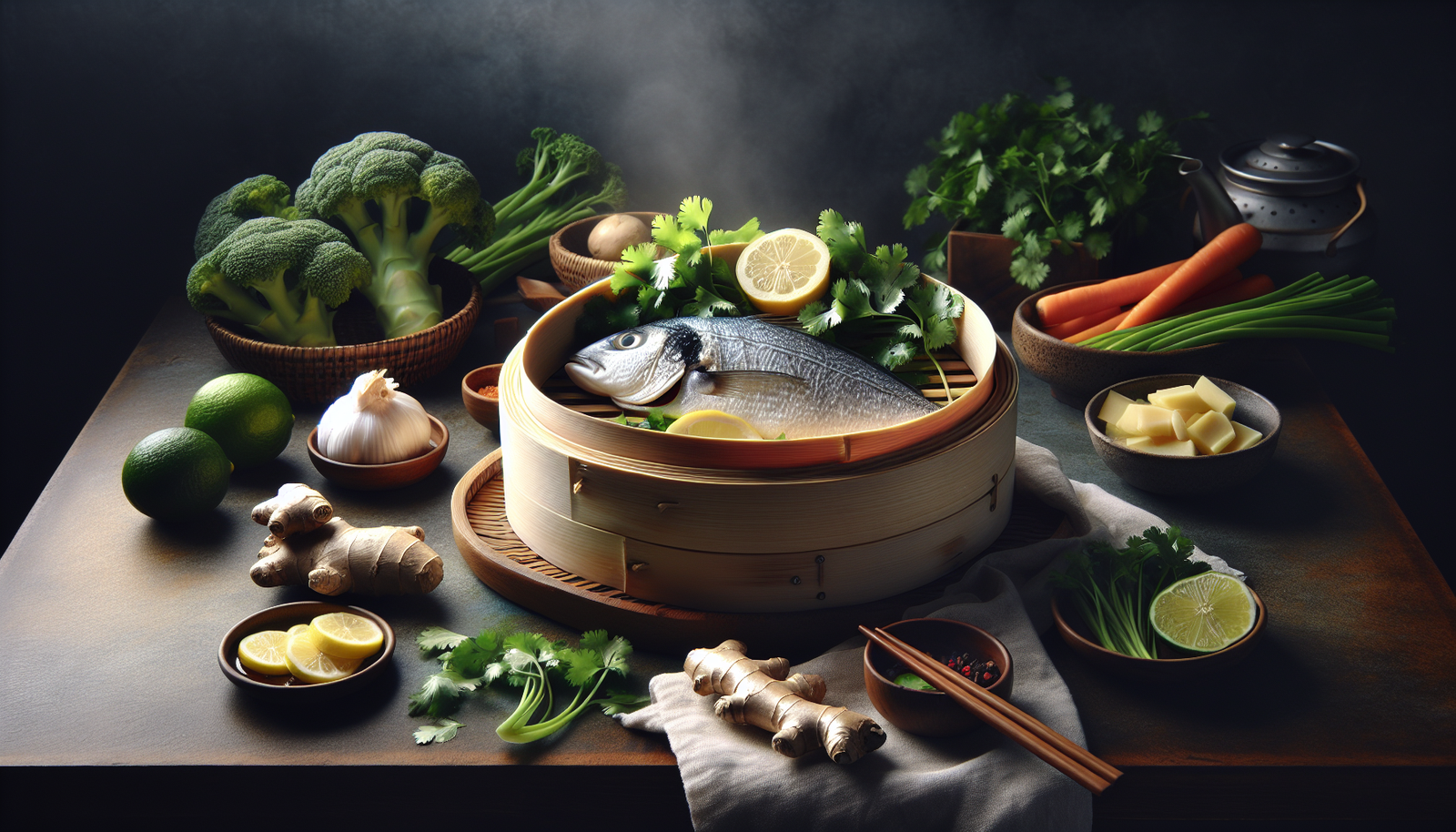
How to Steam Fish for a Moist and Healthy Dish
Steaming fish is a popular culinary technique that ensures a moist and healthy dish. Unlike other cooking methods, steaming preserves the fish’s natural moisture and enhances its delicate flavor. This post will guide you through essential steps and tips for mastering this technique, offering insights on selecting the best fish, preparing it correctly, and choosing appropriate seasonings. Discover why this method is favored for its health benefits and simplicity, and learn how to infuse flavors that elevate your dish. Dive in to transform your cooking routine with this nutritious approach that promises a tender and flavorful outcome every time.
Introduction to Steaming Fish
Steaming fish is not just a cooking method; it’s an art that enhances the natural flavors and retains the nutrients of fish. This gentle process elevates your culinary experience, making it a favorite among health enthusiasts and chefs alike. Understanding the nuances of steaming fish can transform your meals, offering a delightful combination of taste and nutrition.
Benefits of Steaming Fish for Your Health
Steaming fish offers numerous health benefits that make it an ideal choice for health-conscious individuals. This method preserves the essential nutrients like omega-3 fatty acids, vitamins, and minerals. Unlike frying or grilling, steaming minimizes the use of oils, reducing calorie intake without compromising on flavor. The gentle heat of steaming ensures that the fish remains tender, juicy, and full of its natural goodness. It’s a fantastic way to support heart health, improve brain function, and boost overall well-being.
Why Steaming is Preferred Over Other Cooking Methods
When comparing cooking methods, steaming stands out for its ability to enhance the fish’s natural flavors without adding extra fat. It maintains moisture and texture, providing a delectable, melt-in-your-mouth experience. Other methods, such as frying, introduce unhealthy fats and potential carcinogens. Steaming is a cleaner, more sustainable choice, promoting a healthier lifestyle. This method is also energy-efficient and versatile, allowing you to cook a variety of fish types with ease.
Essential Tools and Equipment for Steaming Fish
To successfully steam fish, having the right tools and equipment is crucial. The basics include a reliable steamer, which can be a bamboo steamer, an electric steamer, or a stovetop setup. A large pot with a tight-fitting lid is essential for stovetop steaming. For electric steamers, make sure it has multiple layers for cooking different dishes simultaneously. A fish spatula and tongs are handy for handling the fish without breaking it. Consider adding a kitchen timer to prevent overcooking, ensuring perfectly steamed fish every time.
Step-by-Step Guide to Steam Fish Perfectly
Mastering the art of steaming fish requires understanding the process from start to finish. Selecting the right fish, preparing it meticulously, and using the correct steaming techniques are key steps. This guide aims to simplify the process, ensuring you achieve perfectly steamed fish that is both delicious and nutritious.
Selecting the Right Type of Fish for Steaming
Choosing the right fish is the first step to successful steaming. Opt for fish that are fresh, firm, and have a mild flavor. Favorites include cod, sea bass, and snapper. These varieties hold up well during steaming and absorb flavors beautifully. Consider the thickness of the fish; thinner cuts cook quickly, while thicker ones may require more time. Ensure the fish is sustainably sourced, supporting ethical and environmentally friendly practices.
Preparing Fish for Steaming: Cleaning and Seasoning Tips
Proper preparation is essential for ensuring the best flavors and textures. Start by thoroughly cleaning the fish, removing scales and entrails. Pat the fish dry with a paper towel to enhance seasoning absorption. Seasoning can be simple or elaborate, depending on your preference. A sprinkle of salt and pepper with a squeeze of lemon is a classic choice. For a more adventurous flavor profile, consider marinating the fish in herbs, garlic, and ginger for 30 minutes before steaming.
Techniques for Steaming Fish: Stovetop and Electric Steamer
Both stovetop and electric steamers offer unique advantages. For stovetop steaming, place the fish on a heatproof plate inside a large pot with water, ensuring the plate sits above the water level. Cover the pot and let the steam cook the fish gently. An electric steamer simplifies the process with controlled settings and timers. Arrange the fish in the basket, set the desired time and temperature, and let the steamer do the rest. Both methods require careful attention to cooking time to prevent overcooking.
Enhancing Flavor and Serving Steamed Fish
Steaming fish is just the beginning. Enhancing its flavor and presenting it attractively are equally important. From creative seasonings to complementary side dishes, serving steamed fish with flair can elevate your dining experience.
Creative Seasoning and Marinades for Steamed Fish
Experimenting with different seasonings and marinades can transform your steamed fish into a gourmet delight. Consider using soy sauce, sesame oil, and scallions for an Asian twist. A Mediterranean approach might include olive oil, basil, and sun-dried tomatoes. Marinades allow the fish to absorb flavors deeply, enhancing its taste profile. Allow the fish to marinate for at least 30 minutes to achieve optimal flavor infusion.
Side Dishes That Pair Perfectly with Steamed Fish
The right side dishes can complement and elevate the flavors of steamed fish. Light and refreshing options such as steamed vegetables, quinoa salad, or herbed rice are excellent choices. Consider a crisp cucumber and dill salad or a tangy tomato and avocado salsa. These sides add variety to the meal, balancing the flavors and textures, and creating a well-rounded dining experience.
Presentation Tips for Serving a Stunning Steamed Fish Dish
Presentation is key to making your steamed fish dish visually appealing. Start by carefully placing the fish on a serving platter, using fresh herbs and lemon slices for garnish. Consider adding a drizzle of olive oil or a sprinkle of sesame seeds for a touch of elegance. Ensure the plate is clean and uncluttered, allowing the fish to be the star of the show. A beautifully presented dish enhances the meal’s appeal and engages your guests’ senses, making the dining experience memorable.
Conclusion
Steaming fish is a healthy cooking method that preserves the fish’s nutrients and enhances its natural flavor. This technique is popular in various cuisines worldwide, particularly in Asian dishes. It typically involves placing the fish above simmering water in a covered pot, allowing the steam to cook it evenly. The method is versatile, allowing for the addition of various herbs and spices to infuse flavors. Steamed fish is often served with simple sauces to complement its delicate taste.
FAQ
How do you steam fish without it falling apart?
To steam fish without it breaking, start with fresh, firm fish. Use a gentle steaming process. Placing the fish on a bed of aromatics like ginger or lemongrass can help maintain its shape. Avoid over-steaming, which can cause it to become too soft.
What is the best type of fish to steam for a healthy meal?
Steaming works well with lean fish like cod, tilapia, or haddock. These types offer a mild flavor and are rich in protein, making them excellent choices for healthy meals. Fatty fish like salmon and trout also steam well and provide beneficial omega-3 fatty acids.
How long should you steam fish for optimal flavor and texture?
Timing depends on the thickness of the fish. Generally, fish should be steamed for about 10 minutes per inch of thickness. Check for doneness by ensuring the fish flakes easily with a fork.
Can you steam fish using a bamboo steamer, and how does it affect the taste?
Bamboo steamers are great for steaming fish as they offer a unique aroma. The natural wood imparts a subtle earthy flavor, enhancing the fish’s taste without overpowering it. Ensure the fish is placed on parchment paper or lettuce leaves to prevent sticking.
What are the best seasonings and herbs to use when steaming fish?
Enhance steamed fish with herbs like dill, parsley, and cilantro. Add flavor with garlic, ginger, and lemon slices. Soy sauce, sesame oil, and scallions provide an Asian twist. Seasonings should complement, not overpower, the fish’s natural taste.
Is there a difference between steaming fish on the stovetop versus using an electric steamer?
Both methods effectively steam fish, but an electric steamer offers consistent heat and ease of use. Stovetop steaming allows for more flavor control with direct access to the pot. Both yield deliciously moist fish when done correctly.











